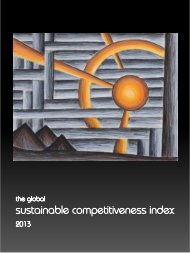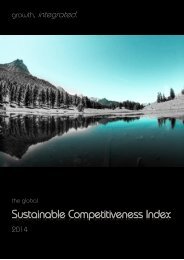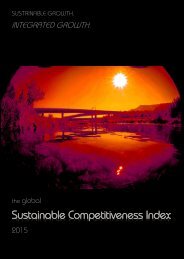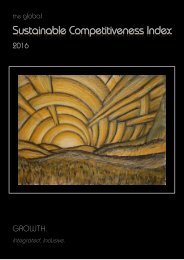The Global Sustainable Competitiveness Index 2019
Measuring competitiveness comprehensively: Sweden & Scandinavia tops, Germany #15, UK 17, US 34, China 37 in the Global Sustainable COmpetitiveness Index 2019
Measuring competitiveness comprehensively:
Sweden & Scandinavia tops, Germany #15, UK 17, US 34, China 37 in the Global Sustainable COmpetitiveness Index 2019
Create successful ePaper yourself
Turn your PDF publications into a flip-book with our unique Google optimized e-Paper software.
Executive Summary
Table of
Contents
Rating comparisons and implications
In order to test the implications of the conventional applied sovereign bond
ratings, a virtual sustainability-adjusted credit rating was calculated. The
sustainability-adjusted rating is equally based on GSCI ratings and conventional
ratings (average of Moody’s, S&P, and Fitch).
Country
Credit rating
(average of M oody's,
S&P; Fitch)
Sustainabilityadjusted
rating
Level
difference
Morocco BBB− BB -2
Paraguay BB+ BBB+ 3
Portugal BBB A 3
Qatar AA− BBB+ -4
Romania BBB− A 4
Saudi Arabia A+ BBB -4
Singapore AAA AA -2
Slovenia A− AA− 3
South Africa BB+ BB -1
Spain A− A 1
United Arab Emirates AA A -3
United Kingdom AA AA+ 1
USA AAA AA -2
Vietnam BB BB+ 1
Based on sustainable competitiveness, countries dependent on exploitation of
natural resources would receive a significant lower credit rating. On the other
hand, some developing nations would receive higher ratings (and therefor lower
interest rates) based on their development potential.
In the asset management world, it is now standard procedure to integrate “E, S
and G” into financial investment risk/opportunity evaluation, while credit ratings
do exclude ESG risks - and therefore do not cover all investor risks. Key
observations:
• Sovereign bond ratings show a high correlation to GDP/capita levels:
Poor countries have to pay higher interest rates than rich countries.
• Sovereign bond ratings do not reflect the non-tangible risks and
opportunities associated with nation economies
• Sustainable adjusted ratings and conventional ratings show significant
differences. Under a sustainability-adjusted credit rating, countries with
high reliance on exploitation of natural resources would be rated lower,
while poor country with a healthy fundament (biodiversity, education,
governance) would receive higher ratings.
It is high time that credit ratings include sustainability in their risk calculations.
8








